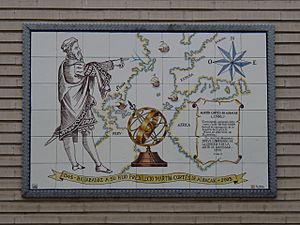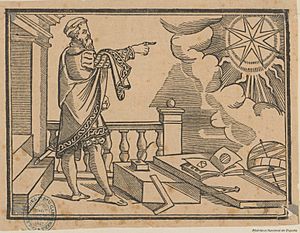Martín Cortés de Albacar facts for kids
Martín Cortés de Albacar (born 1510, died 1582) was a Spanish expert in cosmography. This means he studied the universe, including the Earth and stars, to help people find their way.
In 1551, he published a very important book called Arte de navegar (which means Art of Navigation). This book became the standard guide for sailors. Ten years later, in 1561, his book was translated into English. It became the first English navigation manual that included all the latest sailing techniques of that time.
Cortés was born in Bujaraloz, a town in Aragon, Spain. He grew up in a family of sailors and navigators. This background likely sparked his interest and led to his success in this field. Starting in 1530, he taught cosmography and navigation to pilots in the city of Cádiz. He also shared his knowledge with Spanish Navy ship captains. While we don't know if he fought in battles, his work greatly influenced naval wars during and after his lifetime.
Cortés' famous book, Breve compendio, also known as Arte de navegar, was first published in 1551. Steven Borough, an English explorer, brought the book to England in 1558. He had it translated into English by Richard Eden. It was published in 1561 with the title The Art of Navigation.
This book quickly became very popular. It was the main textbook for European navigation throughout the 1500s and early 1600s. It was updated and reprinted nine times between 1561 and 1630. Famous explorers like Martin Frobisher and Francis Drake used and enjoyed it.
Arte de navegar was a very practical book. Cortés explained navigation, cosmography, and tricky problems like magnetic declination. This is the difference between true north and magnetic north. He even suggested there might be a magnetic pole in the sky.
His book included many drawings and instructions for making instruments. It had the first known description of the Nocturnal. This tool helped sailors tell time at night using the stars. It also showed how to make and use a sea astrolabe.
Cortés' calculations were very important. They helped explorers figure out their exact location when they were far from land.
In 1574, a mathematician named William Bourne created a simpler version of the book. It was called A Regiment for the Sea. Bourne found some parts of Arte de Navegar difficult. So, he made his own guide that was more practical for everyday sailors.
Martín Cortés died when he was 72 years old.
His Life and Teaching
Cortés moved to Cádiz in 1530. There, he attended navigation school and soon became a dedicated teacher. His work was useful for all kinds of navigation, not just at sea.
His main job as a teacher was to certify pilots. He also oversaw the creation and care of nautical charts and instruments. He taught students how to use tools like astrolabes and compasses. Cortés was an expert at applying science and logic to navigation. This helped his students truly understand navigation, not just how to use the tools.
Cortés was also known for his connections with the Spanish Navy. We don't know if he actively fought in battles. However, his work and ideas had a huge impact on important naval conflicts. His contributions were so significant that he received special protection for his works from Álvaro de Bazán. Cortés dedicated his book to Bazán after getting this protection.
While many sources talk about his work, there is little information about his personal life.
See also
 In Spanish: Martín Cortés de Albacar para niños
In Spanish: Martín Cortés de Albacar para niños



